Persistence and retention of weed seeds in the northern grain region of Australia: implications for management
Persistence and retention of weed seeds in the northern grain region of Australia: implications for management
Author: Bhagirath Chauhan, The University of Queensland | Date: 02 Mar 2021
Take home messages
- Seed persistence (at the surface and 2 cm depth) and seed retention of nine weed species was evaluated
- Surface seeds of feathertop Rhodes grass (FTR) and windmill grass (WMG) persisted for <1 year while common sowthistle and Mexican poppy seeds persisted for <1.5 years. Bladder ketmia and sesbania pea seeds persisted for >3.5 years
- Burial increased seed persistence. Buried seeds of Mexican poppy, turnip weed, button grass, bladder ketmia and sesbania pea persisted for >3.5 years
- Turnip weed plants retained all seeds at wheat harvest, whereas common sowthistle dispersed 95% of seeds. Sesbania pea, FTR, and WMG all had greater than 80% seed retention at mungbean harvest, suggesting the most potential of using harvest weed seed control.
Background
Weeds are one of the most important biological constraints to grain production in Australia. In the northern grain region of Australia, weeds cause an annual revenue loss of $140 million, which includes yield loss in wheat, barley, oats, canola, pulses and sorghum, and yield loss from fallow weeds (Llewellyn et al. 2016). These losses can be reduced by adopting integrated weed management (IWM) programs. However, to develop effective and sustainable IWM programs, information on weed biology is a pre-requisite. For example, knowledge of weed seed bank persistence is critical for the development of IWM tactics for herbicide-resistant or difficult-to-control weeds. However, such information is not available for some major and emerging weed species, especially in the northern grain region.
Similarly, information on weed seed retention at crop harvest may be used to create the opportunity to use harvest weed seed control (HWSC) tactics and prevent the build-up of weed seed banks. However, such information is not available for most weed species in the northern region. In this paper, major findings of the ‘Emerging weeds’ project are discussed for seed persistence and seed retention of three winter weeds; common sowthistle (Sonchus oleraceus), Mexican poppy (Argemone mexicana), and turnip weed (Rapistrum rugosum) and six summer weeds; grass species: button grass (Dactyloctenium radulans), feathertop Rhodes grass (FTR; Chloris virgata), liverseed grass (LSG; Urochloa panicoides) and windmill grass (WMG; Chloris truncata); broadleaf species: bladder ketmia (Hibiscus tridactylites) and sesbania pea (Sesbania cannabina). Seed retention of winter weeds was assessed in a wheat crop and summer weeds in a mungbean crop.
Materials and methods
Seed collection
Seeds of common sowthistle, Mexican poppy and turnip weed were collected in October/November 2015 from wheat or chickpea fields. Seeds of bladder ketmia, button grass, FTR, LSG, sesbania pea and WMG were collected in March/April 2016 from sorghum, mungbean or summer fallow fields. Seeds of all species were collected from Dalby, Chinchilla or Gatton regions. Seeds were dried in a screenhouse for 2-3 days.
Seed persistence
Fifty seeds of each species were placed (within 7-10 days after collection) in nylon bags and the bags were buried at 2 cm depth or placed on the soil surface in a field at the Gatton campus of the University of Queensland. There were three replications of each treatment. The bags were exhumed at 3, 6, 12, 18, 24, 30, 36 and 42 months after seed placement in the field and seeds were examined in the laboratory for their germination characteristics (germination, dormancy and viability). In this paper, only the viability component (i.e., seed persistence) is presented. Rainfall for the first year after seed placement is shown in Figure 1.
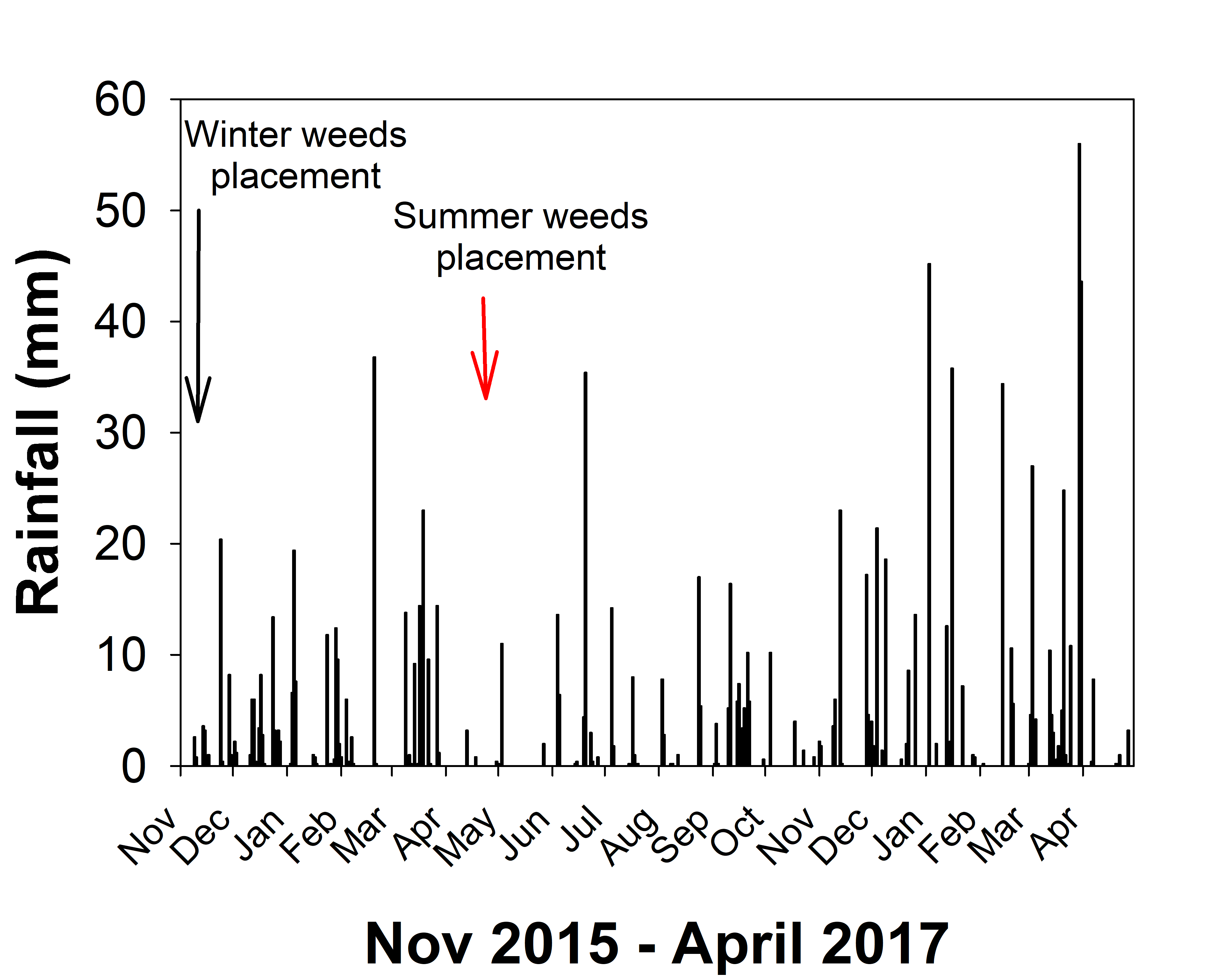 Figure 1. Rainfall (mm) at Gatton from November 2015 to April 2017. Winter weed seeds were placed in the field in November 2015 and summer weed seeds in April 2016.
Figure 1. Rainfall (mm) at Gatton from November 2015 to April 2017. Winter weed seeds were placed in the field in November 2015 and summer weed seeds in April 2016.
Seed retention
Winter weeds (common sowthistle, Mexican poppy and turnip weed) were established in a wheat crop. The crop was planted in May 2016 and May 2017 at a seeding rate of 60 kg/ha in 18 cm row spacing using a tyne seeder. Plots were sprinkle irrigated four times on alternate days starting from seeding to ensure good crop and weed emergence. Seed traps (4 trays/plot) were placed in the field to determine the temporal pattern of seed shed in different weed species. Seeds collected in these traps were retrieved carefully from seed maturity until harvest at a weekly interval to quantify the rate of seed shed. For common sowthistle, seed dispersal was computed based on the numbers of flower heads that dispersed or remained on the plant at the time of harvest.
Summer weeds were established in a mungbean crop. The crop was planted in October 2016 and November 2017 at a seeding rate of 30 kg/ha in 50 cm rows using a tyne seeder. After planting, weed seeds were mixed with sand and broadcast. As mentioned above, plots were regularly watered to ensure good crop and weed establishment. The plots were regularly hand-weeded to remove all weeds except the target species. Seed traps, made of PVC pipes and lined with cloth at the bottom to hold seeds and to drain water, were randomly placed in the crop. Seed retention was computed based on the seeds collected in the traps at crop harvest. These results were also confirmed by visually observing the seed head/panicle/inflorescence.
There were three replications of each treatment in each year; however, data for only one year is shown as the response was similar across the two years.
Results and discussion
Seed persistence
Winter weeds
Common sowthistle seeds placed on the soil surface degraded rapidly, with less than 5% of seeds remaining after 12 months (Figure 2). At 18 months after seed placement, persistence of common sowthistle seeds was zero. Buried seeds took 2 years for complete seed depletion. Common sowthistle seeds have no to very low dormancy levels (Manalil et al. 2018), suggesting that most seeds will germinate after good rainfall events and result in the rapid depletion of the seed bank. Seed burial, by creating dark conditions, may enforce dormancy in some seeds, resulting in longer persistence for buried seeds compared with surface seeds.
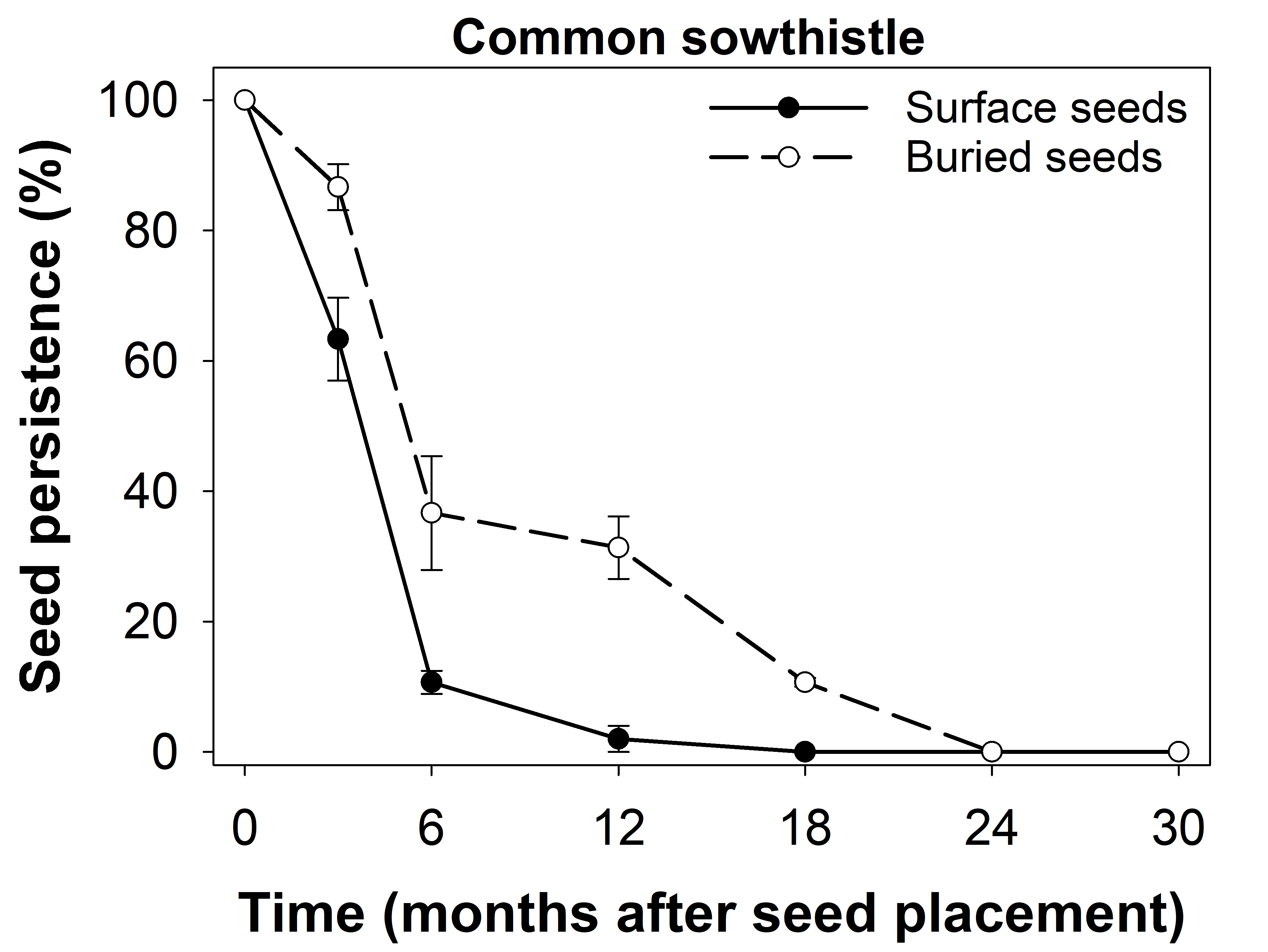 Figure 2. Persistence of common sowthistle seeds placed on the soil surface or buried at 2 cm.
Figure 2. Persistence of common sowthistle seeds placed on the soil surface or buried at 2 cm.
Mexican poppy seeds placed on the soil surface depleted very rapidly, resulting in <10% viable seeds after 3 months (Figure 3). These results of the rapid depletion of the surface seeds were confirmed in another study (data not shown). No seeds remained viable on the soil surface at 18 months. In contrast, this species showed high persistence levels for buried seeds. At 42 months, up to 33% of buried seeds were still viable, suggesting that burial by tillage or planting operations will increase the persistence of Mexican poppy seeds.
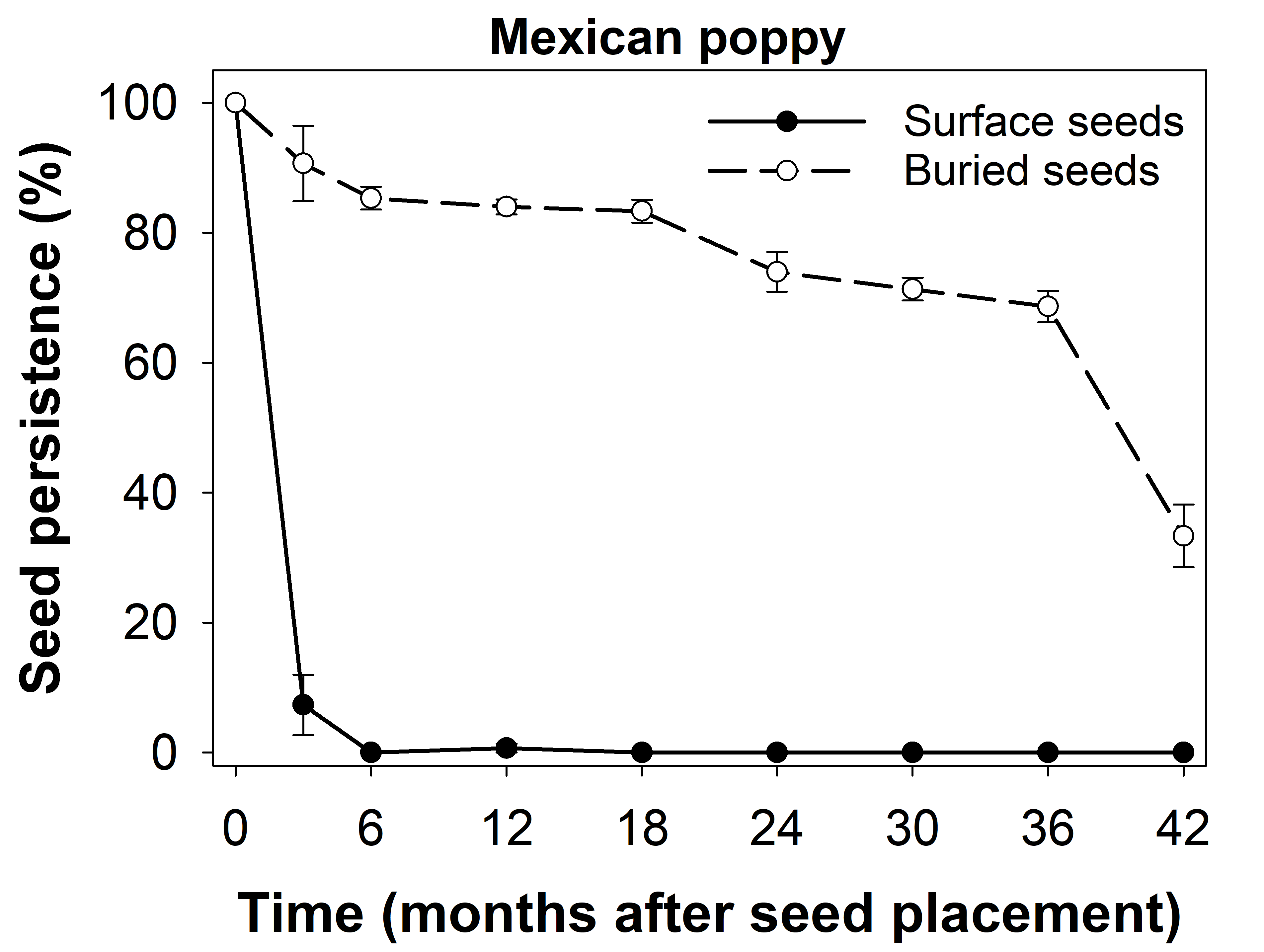 Figure 3. Persistence of Mexican poppy seeds placed on the soil surface or buried at 2 cm.
Figure 3. Persistence of Mexican poppy seeds placed on the soil surface or buried at 2 cm.
In 3 months, about 80% of turnip weed seeds placed on the soil surface were depleted (Figure 4). However, it took 30 months to deplete the rest of the seed bank. Seeds of this species are highly dormant, which is mainly due to the pod wall (Chauhan et al., 2006). Seeds on the soil surface experience high fluctuations in temperature and moisture conditions, which soften the pod wall and allow for high seed germination and depletion. Burial of seeds by any means will delay the decay of the pod wall, resulting in longer persistence of buried seed banks. About 8% of buried seeds of turnip weed were still viable at 42 months (last exhumation in this study).
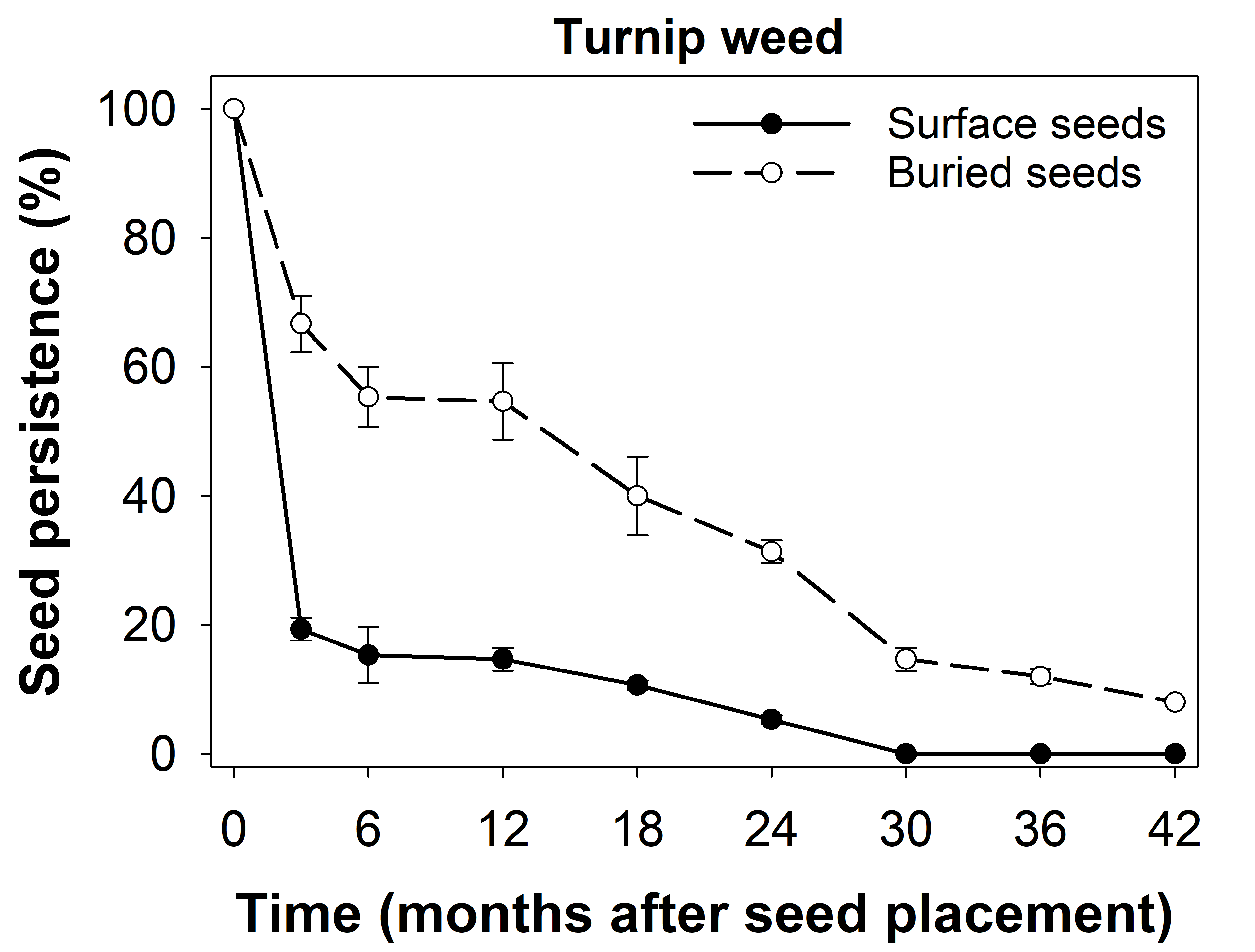 Figure 4. Persistence of turnip weed seeds placed on the soil surface or buried at 2 cm.
Figure 4. Persistence of turnip weed seeds placed on the soil surface or buried at 2 cm.
Summer weeds
Grass species: About 15% of button grass seeds remained viable on the soil surface at 12 months after placement on the soil surface and 5% remained at 24 months (Figure 5). It took 3 years to completely deplete the seed bank of button grass on the soil surface. Buried seeds persisted much longer; 9% of seeds were viable at 42 months. Physical scarification stimulates seed germination in button grass, suggesting that seed burial will delay the natural scarification process and result in longer persistence of button grass seeds.
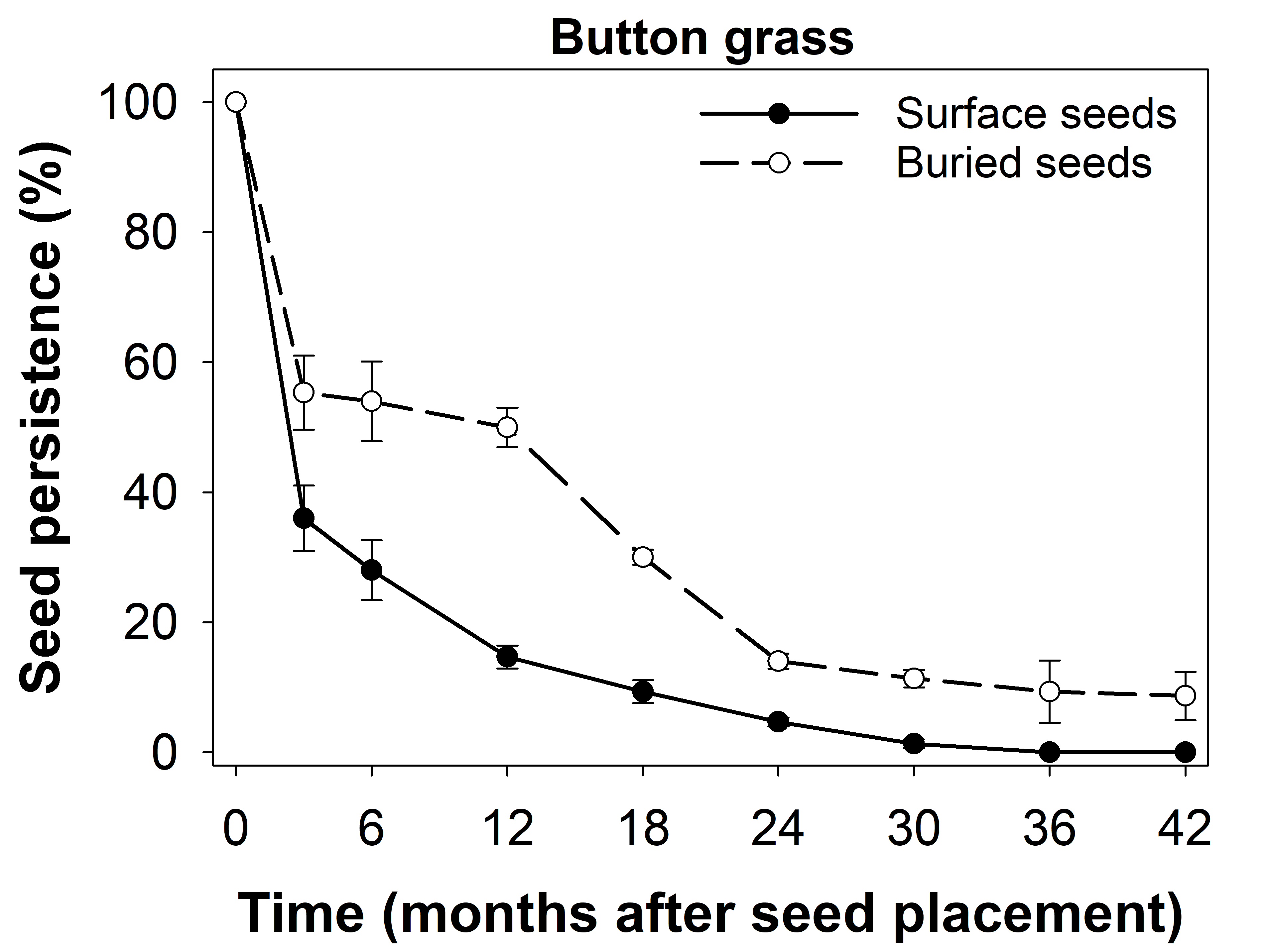 Figure 5. Persistence of button grass seeds placed on the soil surface or buried at 2 cm.
Figure 5. Persistence of button grass seeds placed on the soil surface or buried at 2 cm.
Feathertop Rhodes grass (FTR) seeds on the soil surface depleted very fast (Figure 6). Only 31% of seeds remained viable at 6 months and no surface seeds were found to be viable at 12 months. Buried seeds persisted slightly longer with 9% viable seeds at 12 months and no viable seeds at 18 months. FTR seeds have a moderate level of dormancy and can germinate at a wide range of temperatures ranging from 15/5 °C alternating day/night temperatures to 35/25 °C temperature regimes. Good rainfall events in the first 12 months might have resulted in the germination of most seeds (Figure 1).
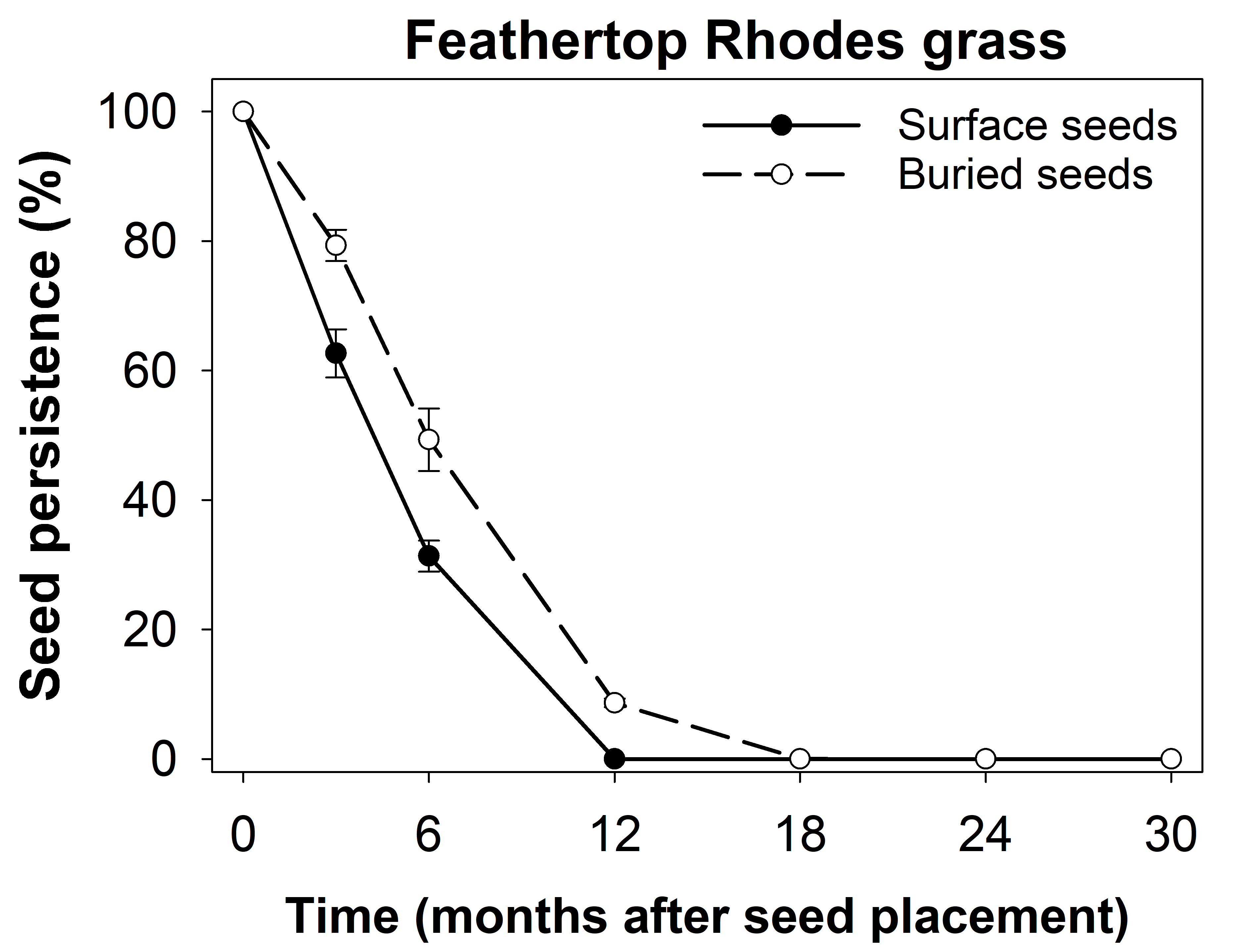 Figure 6. Persistence of feathertop Rhodes grass seeds placed on the soil surface or buried at 2 cm.
Figure 6. Persistence of feathertop Rhodes grass seeds placed on the soil surface or buried at 2 cm.
The depletion of the liverseed grass (LSG) seed bank on the soil surface was significant with 15% of seeds remaining at 12 months, less than 1% at 18 months and no viable seeds at 24 months after seed placement (Figure 7). Buried seeds persisted longer with 12% viable seeds at 24 months and 3% at 36 months. It took 3.5 years to completely exhaust the buried seed bank of LSG. In our lab studies, LSG was found to have a moderate level of seed dormancy. Fresh seeds had 40% germination, which increased to 90% after 4 months. These results suggest that most LSG seeds will germinate in the first years after shedding but some seeds may remain ungerminated in the soil for another two years.
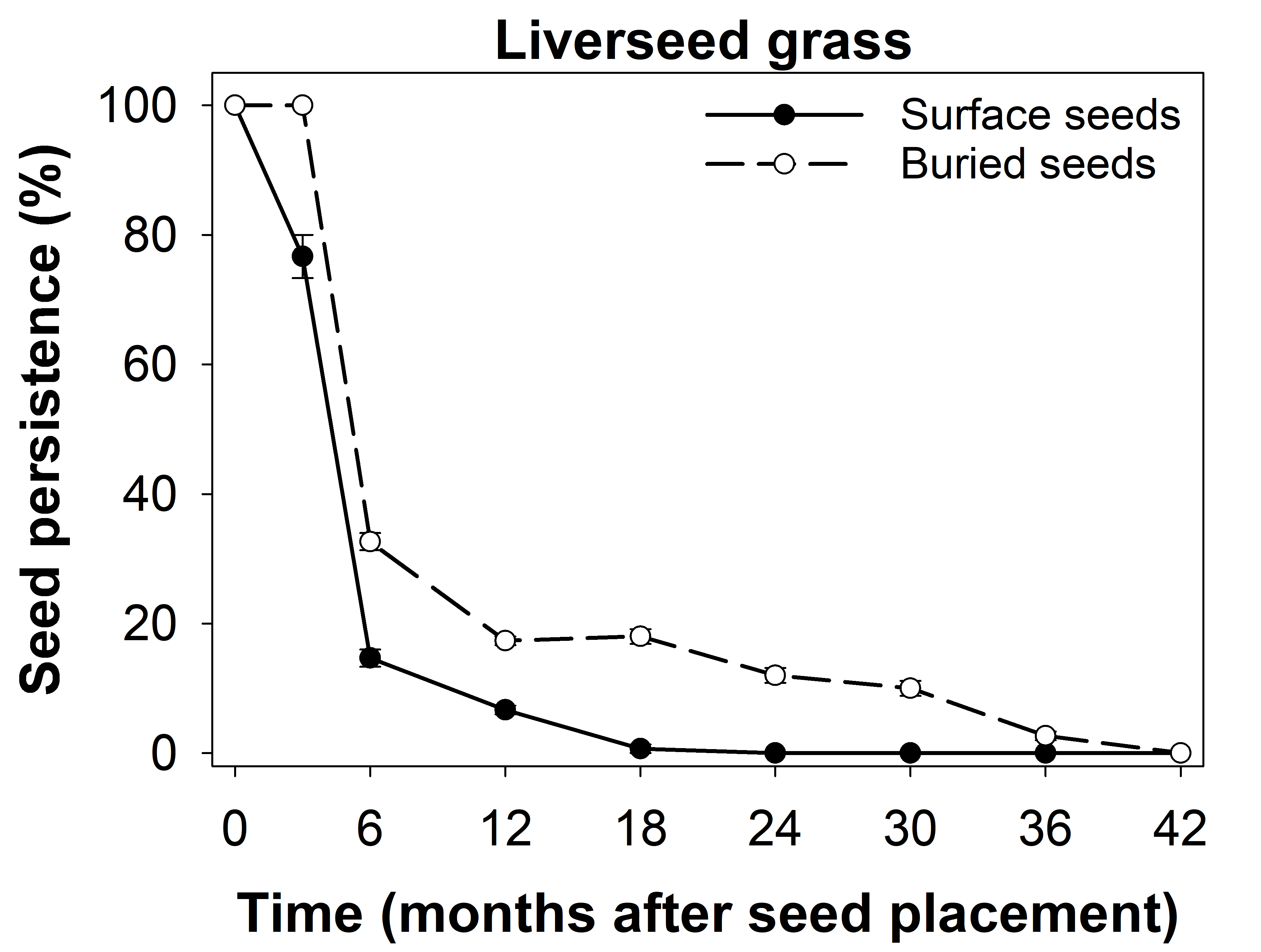 Figure 7. Persistence of liverseed grass seeds placed on the soil surface or buried at 2 cm.
Figure 7. Persistence of liverseed grass seeds placed on the soil surface or buried at 2 cm.
Windmill grass (WMG), a closely related species of FTR, seeds behaved similarly to FTR on the soil surface. Total seed depletion was observed at 12 months after seed placement (Figure 8). Buried seeds of WMG persisted longer than FTR seeds. About 20% of buried seeds were viable at 12 months and 3% at 18 months but no seeds survived at 24 months.
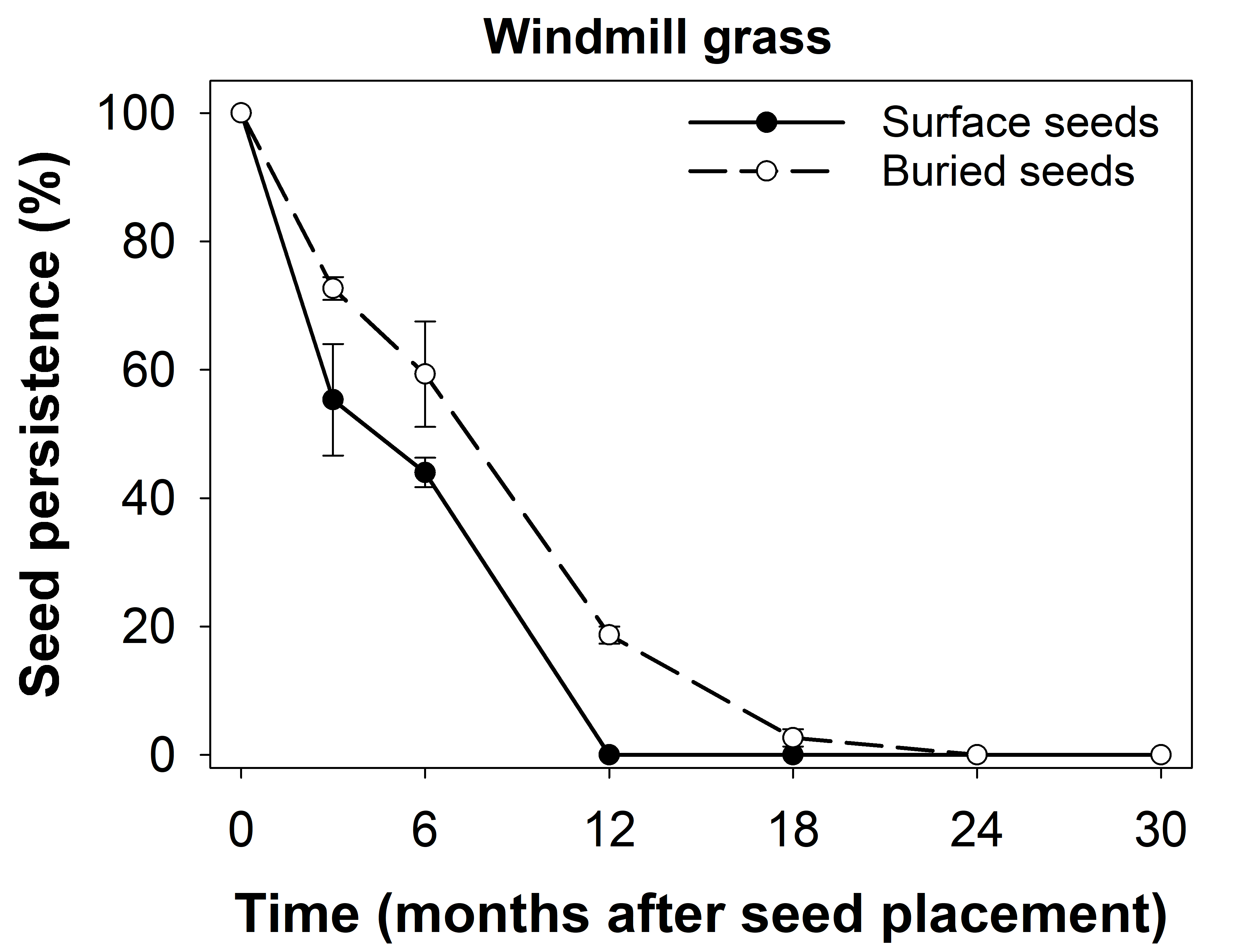 Figure 8. Persistence of windmill grass seeds placed on the soil surface or buried at 2 cm.
Figure 8. Persistence of windmill grass seeds placed on the soil surface or buried at 2 cm.
Broadleaf species: Among all the studied species, bladder ketmia had the greatest level of seed bank persistence. About 3% of the seeds were still viable at 42 months after placement on the soil surface (Figure 9). At the same time, 63% of seeds were viable at 2 cm depth. The time required to lose half of the life of buried bladder ketmia seeds could not be established in this study. Elsewhere, about 25% of bladder ketmia seeds survived after 7 years of burial (Uremis and Uygur, 2005; Westre et al., 1996). This species has hard-seeded or physical dormancy (Chauhan, 2016), suggesting that seed depletion will be quicker for seeds present on the soil surface than when buried in the soil.
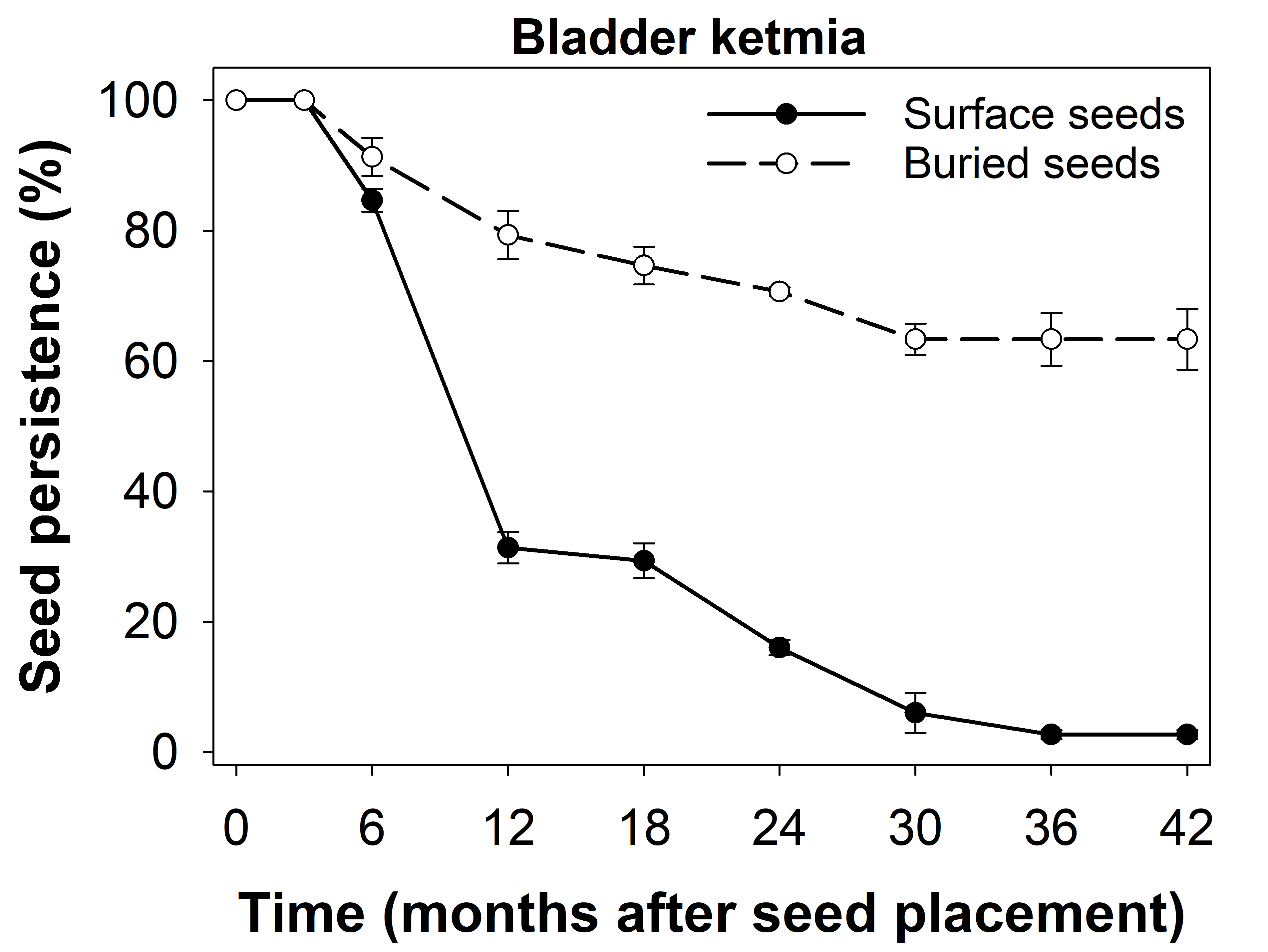 Figure 9. Persistence of bladder ketmia seeds placed on the soil surface or buried at 2 cm.
Figure 9. Persistence of bladder ketmia seeds placed on the soil surface or buried at 2 cm.
Sesbania pea behaved similarly to bladder ketmia as both species are known to have physical seed dormancy (Iqbal et al., 2019). However, the seed bank persistence level of sesbania pea was lower than bladder ketmia. About 1% of surface seeds and 8% of buried seeds were viable at 42 months after seed placement (Figure 10).
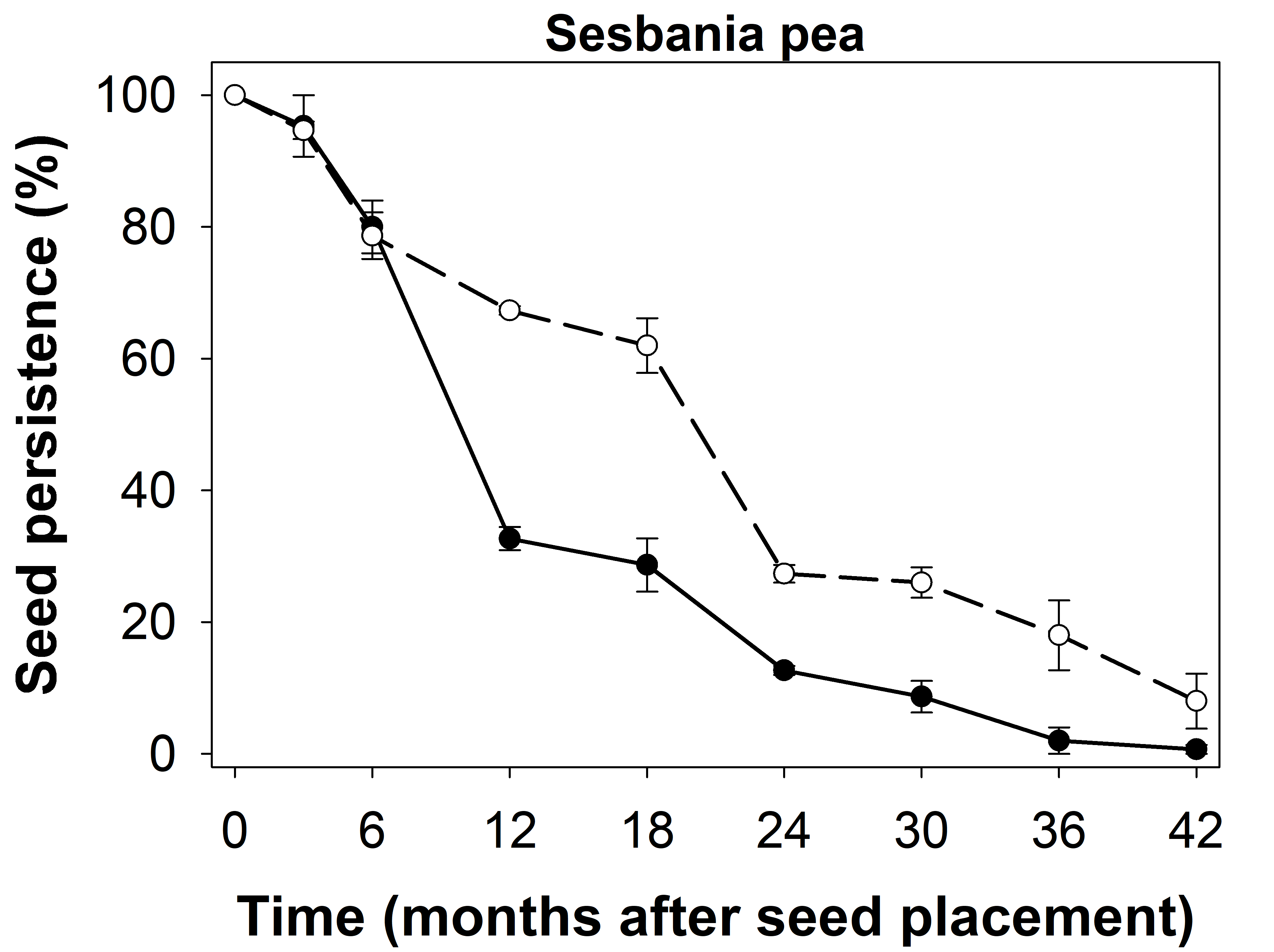 Figure 10. Persistence of seasbania pea seeds placed on the soil surface or buried at 2 cm.
Figure 10. Persistence of seasbania pea seeds placed on the soil surface or buried at 2 cm.
All nine weed species were arranged in ascending order in terms of time required to complete depletion of their seed banks (Figure 11). FTR and WMG surface seeds took the shortest time (12 months) for complete depletion. Common sowthistle and Mexican poppy took 18 months for 100% seed depletion on the soil surface. Surface seeds of bladder ketmia and sesbania pea, both hard-seeded species, were still viable on the soil surface at 42 months, suggesting that these seeds will keep germinating in no-till farming systems beyond 3 years of their shedding. Buried seeds of all weed species persisted longer than surface seeds. This is not a surprising result as buried seeds have reduced risks from seed predators and fatal-germination factors such as high fluctuations in temperature and moisture conditions.
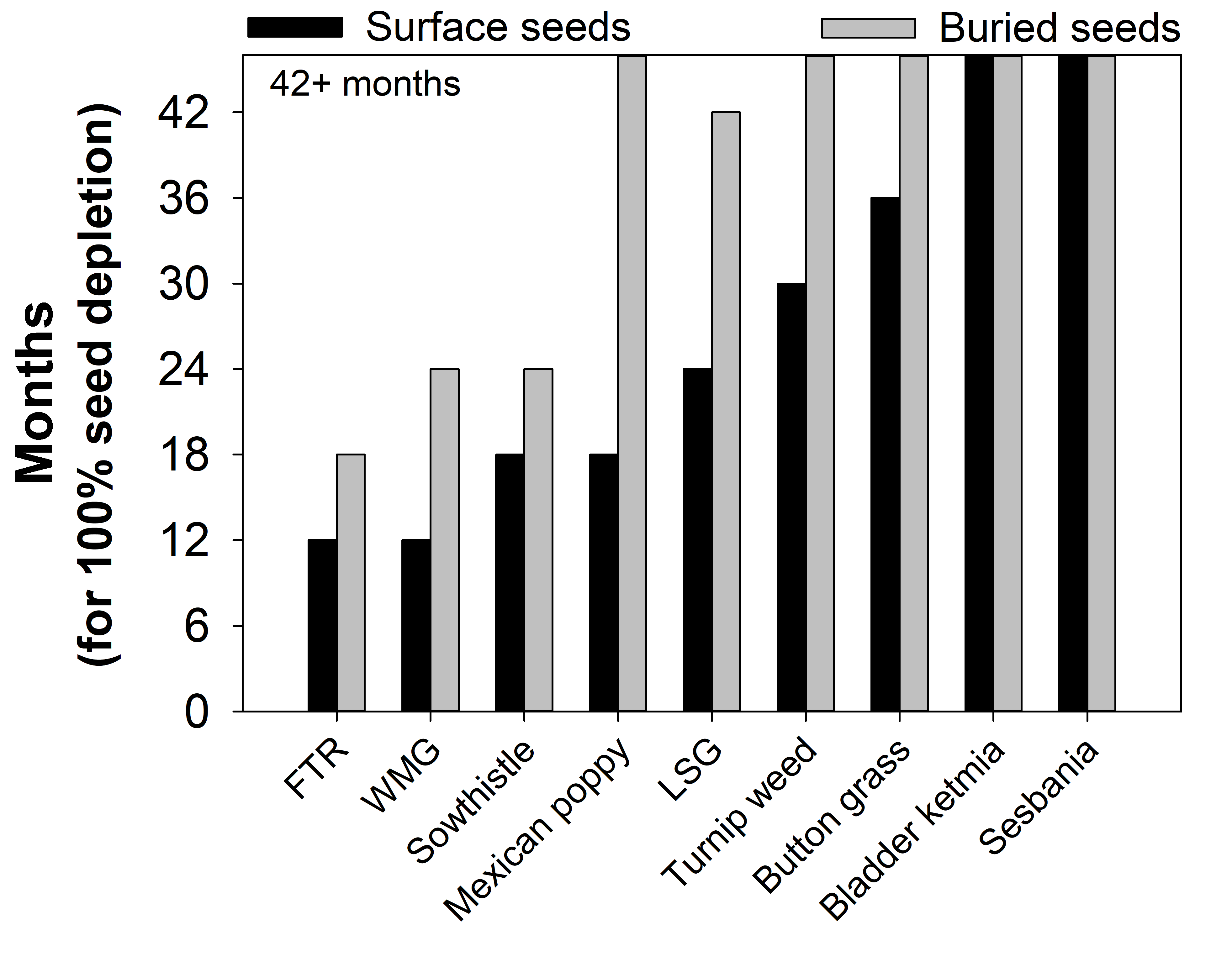 Figure 11. Number of months required to deplete complete seed banks of different weed species. Seeds were placed on the soil surface or buried at 2 cm soil depth. 42+ means more than 42 months.
Figure 11. Number of months required to deplete complete seed banks of different weed species. Seeds were placed on the soil surface or buried at 2 cm soil depth. 42+ means more than 42 months.
Seed retention
Winter weeds in wheat
Common sowthistle produced a maximum of 193,000 seeds/m² but 95% of these seeds had dispersed at wheat crop harvest (Figure 12). In contrast, 100% of seeds were retained for turnip weed, which produced 32,000 seeds/m². These results suggest that turnip weed exhibits high seed retention at wheat harvest and employing HWSC practices is likely to reduce its seed bank in the soil (Manalil and Chauhan, 2019). The author observed that turnip weed in a poorly-established crop in the northern grain region can grow more than 4-5 cm in stem diameter which may impede harvest and HWSC suitability. Therefore, in such situations, seed sterilising practices may need to be used.
Seed-capturing practices may not have desired results for common sowthistle in wheat. As common sowthistle matured much earlier than the wheat crop, most seeds had dispersed before crop harvest (Manalil et al., 2020a). These results suggest that a higher level of seeds of this weed species could be captured in a shorter duration crop or variety. Common sowthistle seeds could also be captured from late-emerging weed seedlings.
 Figure 12. Seed retention (>15 cm from the surface) of winter weeds in a wheat crop. Maximum seed production (seeds/m2) by these species is also given as text.
Figure 12. Seed retention (>15 cm from the surface) of winter weeds in a wheat crop. Maximum seed production (seeds/m2) by these species is also given as text.
Mexican poppy emerged was severely impacted through competition from the 18 cm row wheat crop (Manalil and Chauhan, 2019). These weed plants reduced wheat yield by 20% but did not produce a single seed, suggesting the weed-suppressive benefits of narrow-row planted crops. However growers have observed Mexican poppy seed production in wider row winter cereals, chickpea and winter fallow fields.
Summer weeds in mungbean
Among the broadleaf weed species, sesbania pea retained 100% of seeds at mungbean harvest and bladder ketmia retained 60% of seeds (Figure 13). Among the grasses FTR, WMG, LSG and button grass retained about 95, 85, 75 and 70% of seeds at mungbean harvest. Weeds, such as button grass and FTR, produced more than 100,000 seeds/m², but seed retention of at least 60% suggests opportunities for HWSC. Similar results may not be possible in a longer-duration summer crop, for example, sorghum. In a previous study, only 60% of FTR seeds were retained at sorghum crop harvest (Mahajan et al., 2020).
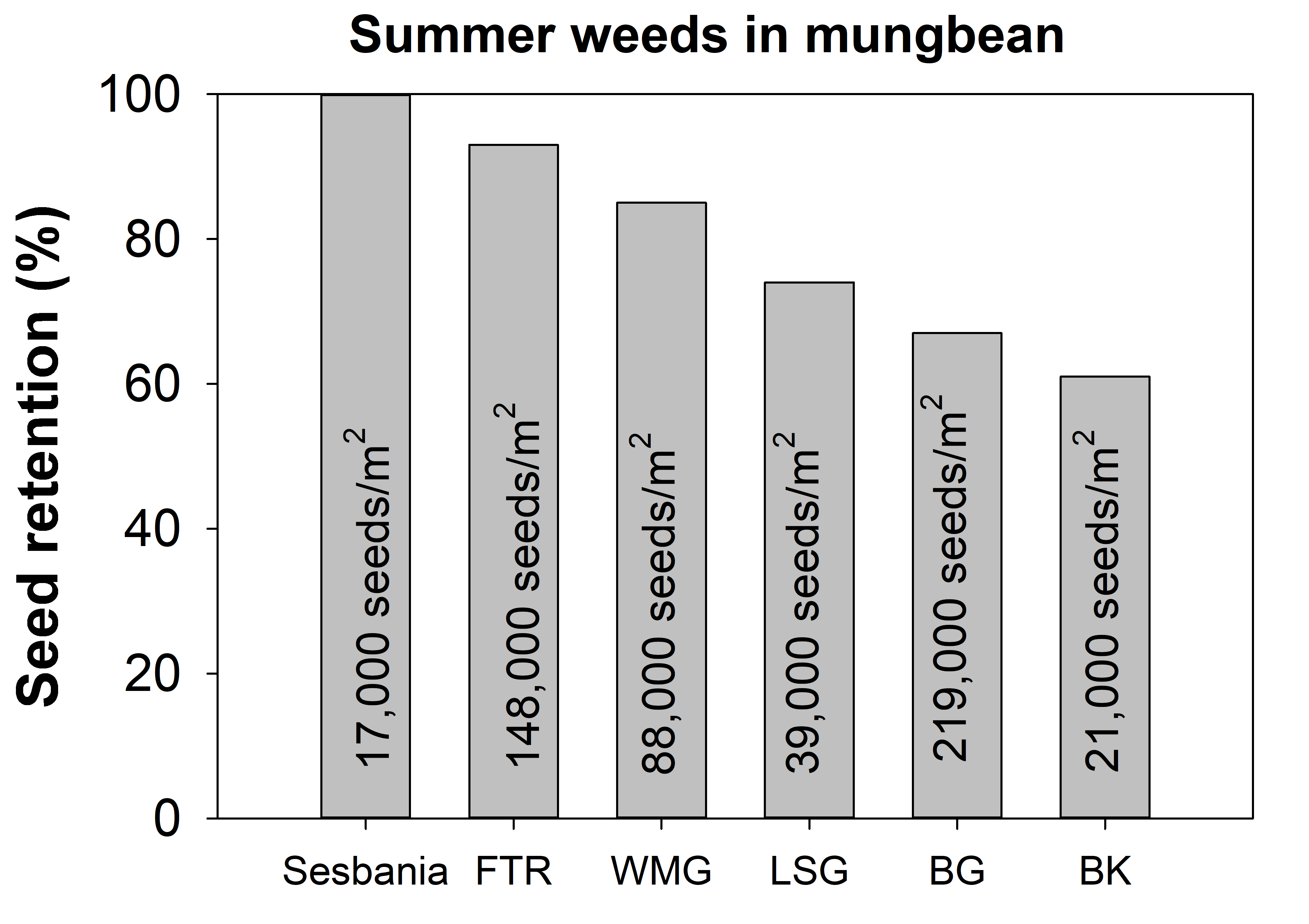 Figure 13. Seed retention of summer weeds in a mungbean crop. Maximum seed production (seeds/m2) by these species is also given.
Figure 13. Seed retention of summer weeds in a mungbean crop. Maximum seed production (seeds/m2) by these species is also given.
Turnip weed, button grass, bladder ketmia and sesbania pea produced a significant number of seeds (Figures 12 and 13), which were found to persist longer than 3.5 years (Figure 11). These characteristics enhance the adaptive potential of such weed species to become problematic and hard-to-control weeds. However, high seed retention and differential maturity periods between crops and weeds provide an opportunity for controlling such weed species through HSWC practices. Crop topping and desiccants may also be possible options in some crops.
FTR is becoming an increasing problem in the northern grain region of Australia. In these trials, it produced almost 150,000 seeds/m² in mungbean; however, its seeds persisted only for a year on the soil surface and 1.5 years in the soil (2 cm depth). These results suggest that prevention of seed set can rapidly deplete seed banks of FTR, and similar weed species. The most effective management of such weeds is to prevent seed set and drive down the existing seed bank through intensive management.
Conclusion
Weed seed bank persistence was variable between species and depths. Seeds persistence ranged from less than 12 months (for example, FTR and WMG) to more than 42 months (for example, turnip weed, Mexican poppy and button grass). Therefore, IWM programs need to consider the variation between weed species. Burial increased seed bank persistence of all nine weed species, suggesting that sowing operations or soil cracks may increase their persistence even in no-till farming systems.
Future research needs to evaluate the seed bank persistence of different weed species in different rainfall regions, soil conditions and crop residue situations. For example, some weeds in southern Australia were found to persist longer in a drier year compared with a wetter year.
With the exception of Mexican poppy in a highly competitive wheat crop in this trial, all the other eight weed species produced a considerable number of seeds and some with very high dormancy levels (e.g., bladder ketmia and sesbania pea). However, except for common sowthistle, all other weed species retained at least 60% of seeds at crop maturity. There is the potential for seed-sterilising and seed-capturing technologies which can reduce further seed input to the soil seed bank. It should be noted that no herbicide weed control was used in this study. Later weed germinations, which often are not controlled by herbicides, may have higher seed retention at harvest. Therefore, there is a need to evaluate seed retention of these weed species in combination with different weed control practices. Similarly, crop planting time and crop row spacing may also affect seed retention by affecting the competitive ability of the crop. Seed retention can also be influenced by weed seedling emergence time through affecting weed phenology, including weed height. Before HWSC practices become a necessary component in the northern region, there is a need to evaluate seed retention affected by the above-said factors.
References
Chauhan BS (2016) Germination biology of Hibiscus tridactylites in Australia and the implications for weed management. Scientific Reports 6:26006
Chauhan BS, Gill G, Preston C (2006) Factors affecting turnipweed (Rapistrum rugosum) seed germination in southern Australia. Weed Science 54:1032-1036
Iqbal N, Manalil S, Chauhan BS, Adkins SW (2019) Germination biology of sesbania (Sesbania cannabina): An emerging weed in the Australian cotton agro-environment. Weed Science 67:68-76
Llewellyn RS, Ronning D, Ouzman J, Walker S, Mayfield A, Clarke M (2016) Impact of weeds on Australian grain production: the cost of weeds to Australian grain growers and the adoption of weed management and tillage practices. Report for GRDC. CSIRO, Australia. In., 112.
Mahajan G, Walsh M, Chauhan BS (2020) Junglerice (Echinochloa colona) and feather fingergrass (Chloris virgata) seed production and retention at sorghum maturity. Weed Technology 34:272-276
Manalil S, Ali HH, Chauhan BS (2018) Germination ecology of Sonchus oleraceus L. in the northern region of Australia. Crop and Pasture Science 69:926-932
Manalil S, Ali HH, Chauhan BS (2020a) Interference of annual sowthistle (Sonchus oleraceus) in wheat. Weed Science 68:98-103
Manalil S and Chauhan BS (2019) Interference of turnipweed (Rapistrum rugosum) and Mexican pricklepoppy (Argemone mexicana) in wheat. Weed Science 67:666-672
Manalil S, Mobli A, Chauhan BS (2020b) Competitiveness of windmill grass (Chloris truncata) and feathertop Rhodes grass (Chloris virgata) in mungbean (Vigna radiata). Crop and Pasture Science 71:916-923
Uremis I and Uygur FN (2005) Seed viability of some weed species after 7 years of burial in the Cukurova region of Turkey. Asian Journal of Plant Sciences 4:1-5
Westra P, Pearson CH, Ristau R, Schweissing F (1996) Venice mallow (Hibiscus trionum) seed production and persistence in soil in Colorado. Weed Technology 10:22-28
Acknowledgements
The research undertaken as part of this project is made possible by the significant contributions of growers through both trial cooperation and the support of the GRDC, the author would like to thank them for their continued support. The author would also like to thank Sudheesh Manalil for conducting the trial in the initial years of the project.
Contact details
Bhagirath Chauhan (Sunny)
The University of Queensland
Building 8115, Gatton, Queensland 4343
Ph: 0427 923 272
Email: b.chauhan@uq.edu.au
GRDC Project Code: UA00156,
